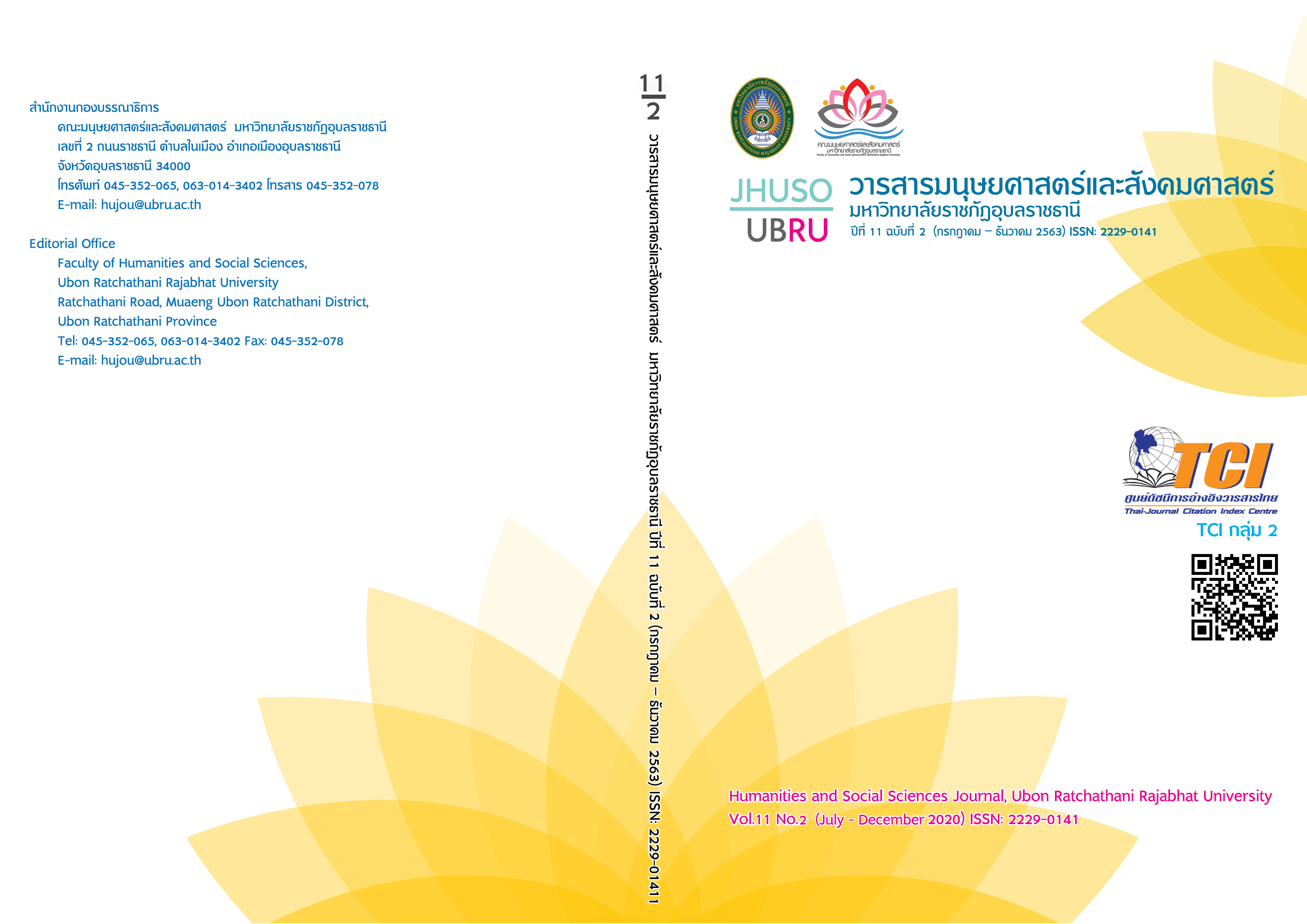การวิเคราะห์คำศัพท์ HSK ในหนังสือเรียนภาษาจีน
Main Article Content
บทคัดย่อ
The objectives of this study were: 1) to analyze the vocabulary found in the Chinese textbooks and the benchmark criterion of the vocabulary in the Chinese Proficiency Test (HSK) Level 1-6; and 2) to analyze the compatibility of the vocabulary in Chinese textbooks with the benchmark of the Chinese Language Proficiency Test (HSK) Level 1-6 in order to be the guidelines for the development and efficiency of teaching and learning Chinese. The samples for this study were 1,369 words with no repetition taken from the Chinese textbooks for 1st year students in the Chinese program, Faculty of Humanities and Social Sciences, Ubon Ratchathani Rajabhat University.
The study showed that 1) There were 752 vocabulary words in the textbooks match the vocabulary words in the benchmark criteria for measuring Chinese language knowledge (HSK) Level 1-6; 2) The words in the textbooks matched those in the HSK Level 1 most (118/150 words), and in Level 2 (247/300 words) respectively. Thus, the students learned HSK vocabulary from Level 1-2 in the textbook for 1st year students most. They were likely to pass HSK Level 3 because the words in HSK Level 3 found in the Chinese textbooks were more than half of those in the benchmark criterion of the HSK Level 3. The way for the development and efficiency of teaching and learning Chinese could be performed both by encouraging and training the students to learn the vocabulary in HSK Level 3 oust-side class, including implementing them with the vocabulary in consonance with such HSK Level when teaching.
Article Details
เอกสารอ้างอิง
Chinese lessons at Elementary Schools of the upper north. Chinese Studies Journal: Kasetsart University, 8(2), 182-188.
Jinchai, Z. (2015). Comparison of Vocabulary of Chinese Teaching Materials in Thailand High School and Vocabulary of PAT 7.4. Master Applied Linguistics, Tianjin University.
Ju Hee, H. (2017). Primary School Chinese Text Book Vocabulary and New HSK Vocabulary Comparison Analysis. Master Applied Linguistics, Shandong University.
Kunacheewa, N. (1987). The Analysis Textbook. Bangkok: saeng-chan-press-limited-partnership.
Ministry of Education, Division of Educational Research. (2000). A research report on the study of literacy of students. A case study of Prathom Suksa 6 and Mattayomsuksa 1 students. Bangkok: Religious Affairs.
Ministry of Education, People's Republic of China. (2005). Chinese Proficiency Test Hanyu
Shuiping Kaoshi (HSK). Beijing: Beijing Language and Culture University.
Oupra, S. (1998). Analysis of Words and Their Semantic Fields Found in the English Textbooks for the Upper Secondary School Level. Master Education, Chiang Mai University.
Tubtim-ngam, B. (1999). Problems, Needs, and Techniques for Developing Required Competencies of English Teachers in Primary Schools in Educational Region 5. Master. Education, Silpakorn University.
Vorayodsri, N. (2001). Alternative : Factors related to achievement in English of students in Rajamangala Institute of Technology Phra Nakhon Tai Campus. Master Education, Srinakharinwirot University.
Xinchun, S. (2006). Comparative Study of GOTCFL and the Glossaries in Two Textbooks. Applied Linguistics Studies, 35(2), 104-110.
Xiaobing, Z. and Nan, C. (2013). An E-Library-Based Study of the Vocabulary in Chinese Textbooks in China and Abroad and Their Localization Features. International Chinese Language Education Studies, 48(2), 268-277.
Yuxiang, W. and Yali, L. (2013). On Word Frequency and Recurrence of Elementary Integrated Chinese Textbooks. TCSOL Studies, 52(4), 75-83.
Zhiyu, W. (2013). A Comparative Analysis on Vocabularies of Thailand PAT7.4 Test and China New HSK Test. Master Applied Linguistics, Tianjin University.


